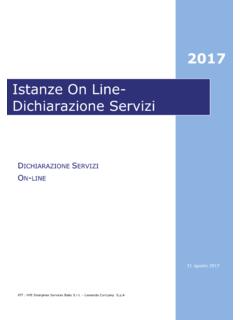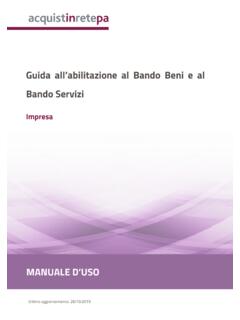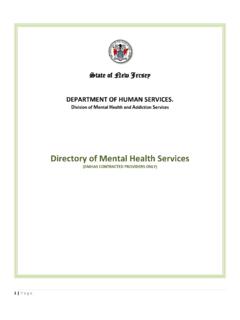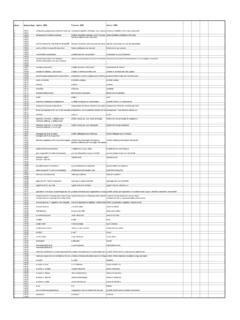Transcription of Common International Classification of Ecosystem ... - CICES
1 Common International Classification of Ecosystem Services ( CICES ) Guidance on the Application of the Revised Structure by Roy Haines-Young and Marion Potschin Fabis Consulting Ltd. The Paddocks, Chestnut Lane, Barton in Fabis, Nottingham, NG11 0AE, UK. Contact email: January 2018. Acknowledgements The revision of CICES was partly supported by work undertaken by Fabis Consulting Ltd, for the EEA. (Support to EEA tasks under the EU MAES process; Negotiated procedure No EEA/NSS/16/002) and through involvement in the EU-funded projects ESMERALDA (Grant Agreement No. 642007) and OpenNESS (Contract No: 308428). Over 200 people contributed ideas shaping this revision of CICES in the 2016 survey of users. To list them all here is inappropriate in terms of confidentiality, but their input is gratefully acknowledged.
2 The input of many others who have also contributed through the various workshop and meetings organised as part of the ESMERALDA and OpenNESS Projects is also gratefully acknowledged. They are listed in Haines-Young et al. (2016) and Potschin and Haines-Young (2016) (see reference list). Special thanks must, however, go to the European Environment Agency, and particularly Jan-Erik Petersen. He has provided much welcome support, encouragement and critical scientific reflection on the process leading up to the completion of this guidance. Suggested citation: Haines-Young, R. and Potschin (2018): Common International Classification of Ecosystem Services ( CICES ) and Guidance on the Application of the Revised Structure.
3 Available from Contents i Executive iii 1. Introduction .. 1. 2. CICES : Conceptual Background .. 3. Final services .. 3. Final services and context .. 4. Abiotic Ecosystem 4. 3. Using CICES .. 7. Defining Ecosystem services in CICES .. 7. CICES : Classification Structure .. 8. Coding CICES Classes .. 10. Aggregation and CICES as a defining and reporting 11. Example services and benefits .. 12. 4. Moving from CICES to .. 14. Provisioning services (biotic) .. 14. Provisioning services (abiotic).. 15. Regulating and Maintenance Services (biotic).. 16. Regulating and Maintenance Services (abiotic) .. 17. Cultural Services (biotic) .. 18. Cultural Services (abiotic) .. 19. Customising CICES .. 19. 5. References .. 20.
4 Appendix 1: Overview of CICES (see accompanying spreadsheet for full details) .. 22. 22. Provisioning (Water also included in abiotic Table).. 23. Regulation and Maintenance .. 24. Cultural .. 25. Abiotic extension .. 26. Appendix 2: Report of Results of a Survey to Assess the Use of CICES , 2016 .. 27. ii Executive Summary Background i. The version of the Common International Classification of Ecosystem Services ( CICES ) in current use ( ) was published in 2013. On the basis of the experience gained by the user community its structure and scope has been reviewed, and a fully revised version ( ) has been developed. This document describes the revision and the process underlying it. Tables setting out the new version and its relationship to can be downloaded from ii.
5 The work on Version 5' was informed by a review of the relevant scientific literature, the results of the 2016 Survey conducted by Fabis Consulting Ltd. for the EEA, and workshops held in 2016 as part of the EU-funded ESMERALDA and OpenNESS Projects. The revision has also been shaped by discussion at a meeting hosted by the United Nations Statistical Division (UNSD), in New York, in June 2016 which was supported by the EEA, and a subsequent workshop in Wageningen, in November 2016, co-organised between the EEA, US-EPA and UNSD. The resulting final draft proposal was circulated again to members of the EU KIP INCA. project and a small group of European and International experts associated with the SEEA. technical review committee as This review round resulted in final modifications which form the basis for the current updated version ( ) that is being presented to the London Group.
6 Scope and focus of Version iii. In CICES Ecosystem services are defined as the contributions that ecosystems make to human well-being, and distinct from the goods and benefits that people subsequently derive from them. These contributions are framed in terms of what ecosystems do' for people. Thus, in the revised version the definition of each service identifies both the purposes or uses that people have for the different kinds of Ecosystem service and the particular Ecosystem attributes or behaviours that support them iv. CICES aims to classify the contributions that ecosystems make to human well-being that arise from living processes. Although biotic Ecosystem outputs remain the focus in , feedback from the user community to broaden the Classification to cover abiotic outputs has been addressed.
7 The new version allows users to select only those Ecosystem services that depend on living systems ( biodiversity in its broadest sense) or to include the non-living parts of ecosystems that can also contribute to human well-being. v. The importance of providing detailed guidance to help people apply the Classification was one of the key points to arise from the consultation on The more formal and systematic definitions provided in will help people identify more easily what the different services categories cover. The new structure also provides examples of the services themselves and types of associated benefit. In order to help users to work in more informal settings with the Classification , suggestions for simpler non-technical names for services are also provided in the new Classification structure.
8 Iii Compatibility with vi. The hierarchal structure that was the basis of CICES has been retained; at the highest level in the Classification services are grouped according into three Sections that relate to whether the contributions to human well-being support a) the provisioning of material and energy needs, b) regulation and maintenance of the environment for humans, or c) the non- material characteristics of ecosystems that affect physical and mental states of people. vii. Although the majority of the classes included in carry over to , their ordering and coding has been modified in the new version to enable users to more easily aggregate Classes for reporting purposes. The Classification structure for provisioning services has, for example, been modified in to permit aggregation where no end use' is known so that the Classification can be more easily used for accounting purposes.
9 A full set of equivalences at Class level have been provided to enable users to make the transition to viii. In response to the difficulties that some users had in using CICES to classify cultural Ecosystem services, the definitions in this Section of the Classification have been revised to better distinguish services from benefits. Thus, cultural services are now seen as the characteristics of elements of nature that provide opportunities for people to derive cultural goods or benefits. In the new version, cultural services are grouped into those opportunities that are realised from direct contact with nature or a more remote type of interaction; in the case of direct contact services are further classified according to whether the interaction is active or passive.
10 CICES as a reference Classification ix. In addition to providing a way to classify Ecosystem services, CICES was also intended as a reference Classification that would allow translation between different Ecosystem service Classification systems, such as those used by the Millennium Ecosystem Assessment (MA), The Economics of Ecosystems and Biodiversity (TEEB). This feature has been retained in , and equivalence tables will be provided via the CICES web-site ( ). Draft Tables for equivalences between CICES and the USEPA FEGS1 (Landers et al. 2016). categories are also available. 1. iv 1. Introduction The Common International Classification of Ecosystem Services ( CICES ) has been designed to help measure, account for, and assess Ecosystem services.






